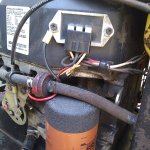Greatwhitewing
Member
- Joined
- Sep 18, 2019
- Threads
- 3
- Messages
- 13
Well thank you very much for your detailed reply and kind offer to help along the way.
I have an acquaintance who does small engine repair. Actually my wife and his wife are good friends and I think I'll just muddle through this season jumping and let him fix it up over the off season.
I may try testing battery again, and bypassing ignition switch and solenoid again with and without spark plug to see what that reveals.
Much rather trash it get something zero-turn but that's not in the cards right now.
If you can suggest any other tests to help troubleshoot I am all ears.
Thanks again
I have an acquaintance who does small engine repair. Actually my wife and his wife are good friends and I think I'll just muddle through this season jumping and let him fix it up over the off season.
I may try testing battery again, and bypassing ignition switch and solenoid again with and without spark plug to see what that reveals.
Much rather trash it get something zero-turn but that's not in the cards right now.
If you can suggest any other tests to help troubleshoot I am all ears.
Thanks again
A cam shaft is not a difficult job, but a big one with all of the cleaning & adjusting and of course it is an engine out job.
That is a fairly old mower so it is up to you if you feel it is worth it.
No problems with B & S cause their parts are cheap but Kohler parts are much more expensive.
My customers generally spring for a replacement engine & I give them a reasonable trade in on the dead one.
I keep telling myself that I will pull few down & make a good one or two out of them but it rarely happens .
Mostly I sell 3 to a novice racer for what I traded them for.
Parts books & service books are available directly from Kohler as a free download but I find it easier to go here https://www.mymowerparts.com/pdf/Kohler-Service-and-Repair-Manuals/
To do a cam shaft you will also need at least a sump gasket, rocker gasket & crankshaft oil seal.
In theory you can leave the head on.
I always take it off ( customer pays for the new gasket in any case ) to check the bore as I give 12 months on repairs.
If you want to go through with it then take lots of photos, particularly of the controls & springs on the controls.
We will be here to walk you through it.
Not particularly difficult but a first timers should allocate a weekend or two as just getting the drive pulleys off can be an all day affair.

